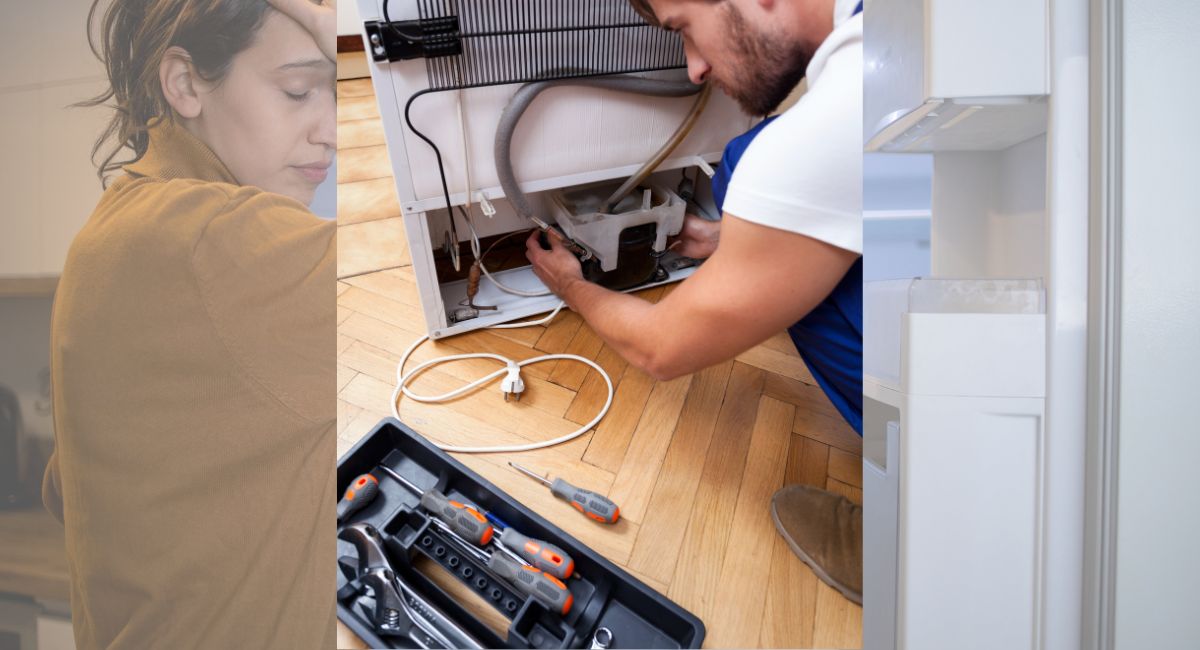Last Updated on August 24, 2023 by Kravelv Spiegel
Fridge issues are an everyday occurrence and may be easily fixed; others, however, may require professional intervention to rectify.
Noisy fridges may be caused by broken seal or an abundance of food being packed inside. Over time, evaporator fans may become noisy and restrict airflow.
An refrigerator that fails to cool can often be traced back to an issue with its temperature control thermostat or thermistor, which requires professional help in order to fix. A repair technician should be available and available immediately when this occurs. Also, remember that Google can easily help you make good choices. Just look for something like “my Kenmore refrigerator is not making ice”.
Water Leakage
If there is water accumulating under your refrigerator, the first step should be to mop up and drain it off before laying out newspapers in its place and monitoring for several days afterwards.
Refrigerators are designed to leak a small amount of water, but any excess should collect in a plastic drain pan beneath the appliance and evaporate via its defrost drain. However, if this pan develops holes or cracks it could escape and flood your floor instead.
Your water line that supplies your ice maker and water dispenser might also be blocked or frozen, so it is a good idea to unplug and move the refrigerator from its wall position before inspecting its supply line – usually constructed of nylon or braided plastic with two tight connection points – using a turkey baster filled with hot water, use this to unfreeze the line if frozen then try using bottle brush or pipe cleaner to clear any remaining blockages in its path.
Temperature Change
Refrigerators rely on cool air being circulated through them to keep food cold and fresh, but if this air can’t escape because the fridge is overcrowded or something else has blocked its path, its temperature will change drastically and make everything hotter or colder than before.
Another frequent cause of temperature fluctuations in your fridge is due to a defective door seal. If this seal fails to keep cool air in, cold air will leak out constantly, prompting it to overcompensate and become too warm. You can check for bubbled, warped, or dirty parts on the seal by looking out for bubbled parts, warps, or dirties which should then be addressed according to manufacturer’s specifications.
If the settings on your refrigerator’s thermostat keep fluctuating, someone could be unknowingly or intentionally making adjustments. Resetting it might help stabilize its temperature; otherwise, check all vents to make sure they’re clear of food debris; blocked vents could also increase temperatures inside your fridge and cause it to heat up more.
Electricity Consumption
Refrigerators consume an incredible amount of electricity to stay cold. By optimizing its wattage and power usage, you can significantly lower your electricity bills and save yourself some cash in the form of lower utility costs.
Locate and read your appliance’s energy guide sticker, noting the voltage (V) and amps (A). Multiply these figures together to get its running wattage; divide this figure by 24 for its total number of hours plugged in daily, multiply it again by 1,000 to convert this figure to kilowatt-hours, etc.
Maintain the coils of your refrigerator regularly by regularly cleaning away dust and debris that clogs its heat-exchange system, forcing your fridge to work harder in maintaining an ideal cold temperature. Also try limiting door openings; every time cold air escapes when opening the door causes your fridge to work harder to recool itself again. Instead, get everything from your fridge at once and close quickly; also make sure all seals are secure as any poor seal could increase electric bills by 10%!
Clogged Defrost Drain
Clogged defrost drains are one of the most frequent issues a refrigerator might face, typically caused by food debris getting caught up in its defrost drain hole or tube and eventually becoming lodged there and becoming inaccessible to drainage.
This clog can be quickly resolved using a turkey baster or syringe with hot water to flush it through, while for more stubborn blockages like those composed primarily of ice, use a hairdryer set on low heat with its heat spread evenly to avoid overheating.
Before conducting any maintenance or repair on your refrigerator, always unplug it and allow it to cool down completely. Read your owner’s manual in order to identify the drain hole or tube on the back service panel of your appliance, wearing rubber gloves for safety while working. Once disconnected from its drain tube, clean with warm water and mild detergent solution in order to clear any clogs or soap residue that has built up inside.

